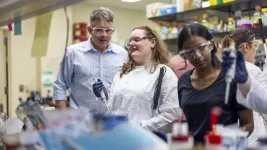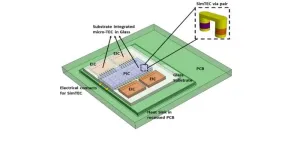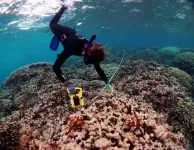(Press-News.org) WACO, Texas (Jan. 10, 2024) – A first-of-its-kind tactile learning device developed by Baylor University chemistry professors to make science accessible to students with blindness or low vision (BLV) has opened the possibility of the transfer of any scientific data or images for sighted students into functional, thorough formats for students with blindness. The study was published today in the journal Science Advances.
The latest research from Bryan F. Shaw, Ph.D., professor of chemistry and biochemistry at Baylor, focused on the development of a codex using lithophane – an ancient art form – to convert images from scientific textbooks into tactile formats for students with BLV. The study, in collaboration with John L. Wood, Ph.D., The Robert A. Welch Distinguished Professor of Chemistry at Baylor, documents experiences from students with the Texas School for the Blind and Visually Impaired (TSBVI), who have partnered with Shaw on a variety of in-person learning opportunities and research projects.
“This is the first example that we know of in which blind high school students are able to visualize nanoscopic and microscopic imagery with tactile sensing at the exact same resolution as their sighted peers,” Shaw said. “That’s the focus of this paper—getting materials in the hands of high schoolers and seeing the results.”
The study, which incorporated students from TSBVI, demonstrated that students with blindness or low vision could accurately describe, recall and distinguish high-resolution data and imagery at an average accuracy of 88 % – comparable to sighted peers.
For Shaw, a burgeoning research focus on science accessibility stems from experiences with his 15-year-old son, Noah, who was diagnosed as an infant with retinoblastoma, an aggressive pediatric eye cancer. Today, Noah is thriving despite losing one eye and having limited vision in his remaining eye, and Shaw has developed a mix of approaches to make science data and science labs accessible to those with blindness and low vision. Past projects have been funded by the National Institutes of Health Science Education Partnership Award, the National Science Foundation and the Robert A. Welch Foundation. Shaw’s latest paper is his fourth in Science Advances.
(See roundup of past research on inclusive science efforts from Bryan F. Shaw’s Baylor laboratory.)
Tactile sensing through ancient medium
TSBVI students were able to visualize this data through the use of lithophanes. Likely created in China as early as the seventh century and popularized in Europe in the 1800s, lithophanes are thin engravings made from translucent materials, now 3D-printed with raised imagery suitable for tactile learning. Through use of lithophanes, students with blindness can feel what their sighted counterparts can see. The study suggests that beginning students can visualize, comprehend and discern high-resolution nanoscopic or microscopic images as well as a sighted person.
A 2022 proof of concept study in Science Advances highlighted the efficacy of lithophanes. The study found that the average test accuracy for all five lithophanes was:
96.7% for tactile interpretation by blind adults,
92.2% for sighted interpretation of back-lit lithophanes and
79.8% for tactile interpretation by blind folded students with normal eyesight.
Sighted participants were able to accurately interpret digital images on a computer screen at 88.4% by eyesight. For 80% of questions, the blind chemists’ tactile accuracy was equal or superior to visual interpretation of lithophanes, suggesting that lithophanes could function as a shareable data format. In fact, Shaw said some of the blind chemists in the study has such tactile sensitivity that they could feel tactile features of the data that sighted individuals could barely see themselves.
The latest study followed TSBVI students in their ability to visualize changes in images from high-resolution, nanoscopic and microscopic images through touch. The students involved in the study were provided their first high-resolution tactile codex (or book) of real-life microscopic and nanoscopic imagery, which also can be found in science books for sighted students.
“Lithophane codexes are just that simple—lithophane books,” Shaw said. “But this is the first example of a lithophane book that we know of and the first time it’s been put in the hands of high-school students.”
For example, students used a tactile codex of a butterfly at various degrees of magnification in an electron microscope. Using the image of a butterfly as the base, students could go deeper into the innerworkings of the insect. They started with the shape of a butterfly, which many of the students had never felt. From there, students felt a butterfly wing image as viewed through a microscope, with fish scale-like images making the intricacy of the butterfly’s wing accessible. Magnified even higher through a microscope, a third image featured a single scale, with the final image showing the chemical structures that comprise the scaled wings of a butterfly.
Students were tested for their understanding of the layers of scales and cells on each lithophane, with students demonstrating mastery of the images through touch.
“When you develop a new drug, you do all the science to create a drug, but when you give it to a person and it works, that testing period is over,” Shaw said. “That’s what we have here through these images and the lithophane codex.”
The study also brought students from TSBVI into research labs at Baylor and introduced them to universal chemical graphics. These graphics allowed students to feel the structures of molecules that were reactants and products in chemical reactions. In real time, students felt different structures of molecules as the molecules were reacted in front of them by graduate students with the Baylor Synthesis and Drug-Lead Discovery Lab, co-directed by Wood.
Equality and accessibility
To help educators who serve these students, Shaw’s team developed an equation to determine how many pages a codex could accommodate based on the diameter of the binding. As an example, the 1000 images found in a standard biochemistry textbook would need four lithophane books measured at 10 centimeters in width.
“Lithophanes make the high-resolution, serious scientific data 100% accessible to students with blindness. They won’t be missing out on anything,” Shaw said. That’s what is beautiful about this. It’s equality and equivalence. We can sit around with sighted and non-sighted people and talk about the exact piece of data, and it’s beautiful.”
Students with blindness and low vision (BLV) have long faced barriers to the study and discipline of chemistry, often due to the long-standing inaccessibility of science labs to people with disabilities, a lack of non-visual educational materials, and technologies not yet optimized for those with visual impairments. Shaw’s laboratory will continue to focus on methods to eradicate those barriers for students with blindness and other disabilities in the future.
“It is critical to show students in high school and even earlier that they belong in science—it is open to them if they want to join—regardless of their diverse abilities, or so-called disability,” Shaw said. “When I think about my son or other children with disabilities, what they do in their 30s and 40s depends on what we do for them now. And many scientists are too busy for that. But at Baylor, it’s not that way. There’s an ethos here.”
ABOUT THE AUTHORS
In addition to Bryan F. Shaw (corresponding author) and John L. Wood, the research team included Emily A. Alonzo (first author), Travis J. Lato, Mayte Gonzalez, Trevor L. Olson, Quentin R. Savage, Levi N. Garza, Morgan T. Green, Jordan C. Koone, Noah E. Cook, Chad M. Dashnaw, Darren B. Armstrong and Matthew J. Guberman-Pfeffer, Ph.D., Department of Chemistry and Biochemistry, Baylor University; Lisa S. Garbrecht, Madeline L. Haynes and Miriam R. Jacobson, Expanding Pathways In Computing (EPIC), Texas Advanced Computing Center; Mona S. Minkara, Ph.D., Department of Bioengineering, Northeastern University; Hoby B. Wedler, Ph.D., Wedland Group, Petaluma, Calif.; and Bernd Zechmann, Ph.D., Center for Microscopy and Imaging, Baylor University.
This project was supported by funding from the National Institutes of Health (R25GM146265), National Science Foundation (CHE: 2203441), and Welch Foundation (AA-1854). J.L.W. acknowledges support from the Welch Foundation (Chair, AA-006) and the National Science Foundation (CHE-1764240).
ABOUT BAYLOR UNIVERSITY
Baylor University is a private Christian University and a nationally ranked Research 1 institution. The University provides a vibrant campus community for more than 20,000 students by blending interdisciplinary research with an international reputation for educational excellence and a faculty commitment to teaching and scholarship. Chartered in 1845 by the Republic of Texas through the efforts of Baptist pioneers, Baylor is the oldest continually operating University in Texas. Located in Waco, Baylor welcomes students from all 50 states and more than 100 countries to study a broad range of degrees among its 12 nationally recognized academic divisions.
ABOUT THE COLLEGE OF ARTS & SCIENCES AT BAYLOR UNIVERSITY
The College of Arts & Sciences is Baylor University’s largest academic division, consisting of 25 academic departments in the sciences, humanities, fine arts and social sciences, as well as 11 academic centers and institutes. The more than 5,000 courses taught in the College span topics from art and theatre to religion, philosophy, sociology and the natural sciences. The College’s undergraduate Unified Core Curriculum, which routinely receives top grades in national assessments, emphasizes a liberal education characterized by critical thinking, communication, civic engagement and Christian commitment. Arts & Sciences faculty conduct research around the world, and research on the undergraduate and graduate level is prevalent throughout all disciplines. Visit the College of Arts & Sciences website.
END
Tactile lithophane development makes hard scientific data available to students with blindness
Baylor chemist-led research team advances efforts to make science accessible to individuals with blindness or low vision
2024-01-10
ELSE PRESS RELEASES FROM THIS DATE:
Glass packaging with a mix of thermoelectric in the vias
2024-01-10
Photonics offers various advantages, including enablement of high-speed and low-loss communication by leveraging light properties in optical data communication, biomedical applications, automotive technology, and artificial intelligence domains. These advantages are realized through complex photonic circuits, comprising diverse photonic elements that are integrated on a photonic chip. Electronic chips are then added to supplement the photonic chips for certain functions, such as light source operation, modulation, and amplification. The close integration of electronic and photonic chips on a substrate is a critical aspect of photonic packaging.
Photonic packaging plays a vital role in ...
Genetics may influence the body’s response to low oxygen, Pitt study finds
2024-01-10
PITTSBURGH, Jan. 10, 2024 – University of Pittsburgh Schools of Medicine researchers uncovered a fundamental mechanism that controls the body’s response to limited oxygen and regulates blood vessel disease of the lung.
By combing through genomes of more than 20,000 individuals in the U.S., France, England and Japan and combining the results with molecular studies in the lab, the team discovered a shared genetic trait that could predict a higher risk of small lung vessel disease called pulmonary hypertension and its more severe ...
mRNA technology could be possible treatment for rare diseases
2024-01-10
By exploiting the technology used in Covid-19 vaccines, a team led by UCL, King’s College London and Moderna scientists has created an effective therapy for a rare disease, in a study in mice, demonstrating the technology’s potential therapeutic use in people.
The research, published in Science Translational Medicine, found that messenger RNA (mRNA) could be used to correct a rare liver genetic disease known as argininosuccinic aciduria in a mouse model of the disease.
Argininosuccinic aciduria is an inherited metabolic disorder that affects how the body ...
Feeling depressed linked to short-term increase in bodyweight, study finds
2024-01-10
Increases in symptoms of depression are associated with a subsequent increase in bodyweight when measured one month later, new research from the University of Cambridge has found.
The study, published today in PLOS ONE, found that the increase was only seen among people with overweight or obesity, but found no link between generally having greater symptoms of depression and higher bodyweight.
Research has suggested a connection between weight and mental health – with each potentially influencing the other – but the relationship is complex and remains poorly understood, ...
NIH-supported researchers create single-cell atlas of the placenta during term labor
2024-01-10
WHAT:
An atlas revealing the activity of individual placental cells during childbirth offers insight on what happens at the maternal-fetal interface during term labor, according to a study supported by the National Institutes of Health (NIH). The atlas provides a single-cell analysis of the human placenta and its surrounding membranes and is the first to use this method to understand the communication that occurs between maternal and fetal cells during the process of labor. Studying these processes aids understanding of typical labor and delivery at term, as well as preterm labor and delivery, which occurs before ...
Neuropsychological effects of rapid-acting antidepressants may explain their clinical benefits, new research finds
2024-01-10
Rapid-acting antidepressants, including ketamine, scopolamine and psilocybin, have been found to have immediate and lasting positive effects on mood in patients with major depressive disorder but how these effects arise is unknown. New research led by the University of Bristol explored their neuropsychological effects and found that all three of these drugs can modulate affective biases associated with learning and memory.
The paper, published in Science Translational Medicine today [10 January] was carried out in collaboration with researchers at Compass Pathways, Boehringer Ingelheim, and the University of Cambridge.
Negative affective ...
Record heat in 2023 worsened global droughts, floods and wildfires
2024-01-10
Record heat across the world profoundly impacted the global water cycle in 2023, contributing to severe storms, floods, megadroughts and bushfires, new research from The Australian National University (ANU) shows.
The findings are outlined in a new report released today by the Global Water Monitor Consortium and led by ANU researchers.
Lead author Professor Albert Van Dijk, from ANU, said the report underscores the consequences of persistent fossil fuel burning on natural disasters, water resources, biodiversity and food security.
“Record-breaking heat waves swept across the globe in 2023, shattering previous records, from Canada to Brazil and from Spain to Thailand,” ...
MD Anderson research highlights for January 10, 2024
2024-01-10
HOUSTON ― The University of Texas MD Anderson Cancer Center’s Research Highlights showcases the latest breakthroughs in cancer care, research and prevention. These advances are made possible through seamless collaboration between MD Anderson’s world-leading clinicians and scientists, bringing discoveries from the lab to the clinic and back.
Recent developments at MD Anderson include insights into the effects of the gut microbiome on remote tumors, a screening strategy for ovarian cancer early detection, a combination approach ...
Newly identified genes for depression may lead to new treatments
2024-01-10
More than 200 genes linked to depression have been newly identified in a worldwide study led by UCL researchers.
The research, published in Nature Genetics, found more than 50 new genetic loci (a locus is a specific position on a chromosome) and 205 novel genes that are associated with depression, in the first large-scale global study of the genetics of major depression in participants of diverse ancestry groups.
The study also showcases potential for drug repurposing, as one of the identified genes encodes a protein targeted by a common diabetes drug, while also pointing to new targets for drugs that ...
In hot water: coral resilience in the face of climate change
2024-01-10
From intensifying wildfires to record-breaking floods year on year, the effects of climate change have manifested in devastating outcomes on ecosystems that threaten species all over the world. One such ecosystem in peril is coral reefs, which play a major role in sustaining biodiversity in the planet’s oceans but are facing increasingly severe conditions as waters heat up leading to a phenomenon known as marine heat waves.
For nearly a decade, Katie Barott, assistant professor of biology at the University ...
LAST 30 PRESS RELEASES:
Plant hormone allows lifelong control of proteins in living animal for first time
Swedish freshwater bacteria give new insights into bacterial evolution
Global measures consistently underestimate food insecurity; one in five who suffer from hunger may go uncounted
Hidden patterns of isolation and segregation found in all American cities
FDA drug trials exclude a widening slice of Americans
Sea reptile’s tooth shows that mosasaurs could live in freshwater
Pure bred: New stem cell medium only has canine components
Largest study of its kind highlights benefits – and risks – of plant-based diets in children
Synergistic effects of single-crystal HfB2 nanorods: Simultaneous enhancement of mechanical properties and ablation resistance
Mysterious X-ray variability of the strongly magnetized neutron star NGC 7793 P13
The key to increasing patients’ advance care medical planning may be automatic patient outreach
Palaeontology: Ancient tooth suggests ocean predator could hunt in rivers
Polar bears may be adapting to survive warmer climates, says study
Canadian wildfire smoke worsened pediatric asthma in US Northeast: UVM study
New UBCO research challenges traditional teen suicide prevention models
Diversity language in US medical research agency grants declined 25% since 2024
Concern over growing use of AI chatbots to stave off loneliness
Biomedical authors often call a reference “recent” — even when it is decades old, analysis shows
The Lancet: New single dose oral treatment for gonorrhoea effectively combats drug-resistant infections, trial finds
Proton therapy shows survival benefit in Phase III trial for patients with head and neck cancers
Blood test reveals prognosis after cardiac arrest
UBCO study finds microdosing can temporarily improve mood, creativity
An ECOG-ACRIN imaging study solves a long-standing gap in metastatic breast cancer research and care: accurately measuring treatment response in patients with bone metastases
Cleveland Clinic presents final results of phase 1 clinical trial of preventive breast cancer vaccine study
Nationally renowned anesthesiology physician-scientist and clinical operations leader David Mintz, MD, PhD, named Chair of the Department of Anesthesiology at the UM School of Medicine
Clean water access improves child health in Mozambique, study shows
Study implicates enzyme in neurodegenerative conditions
Tufts professor named Fellow of the National Academy of Inventors
Tiny new device could enable giant future quantum computers
Tracing a path through photosynthesis to food security
[Press-News.org] Tactile lithophane development makes hard scientific data available to students with blindnessBaylor chemist-led research team advances efforts to make science accessible to individuals with blindness or low vision






